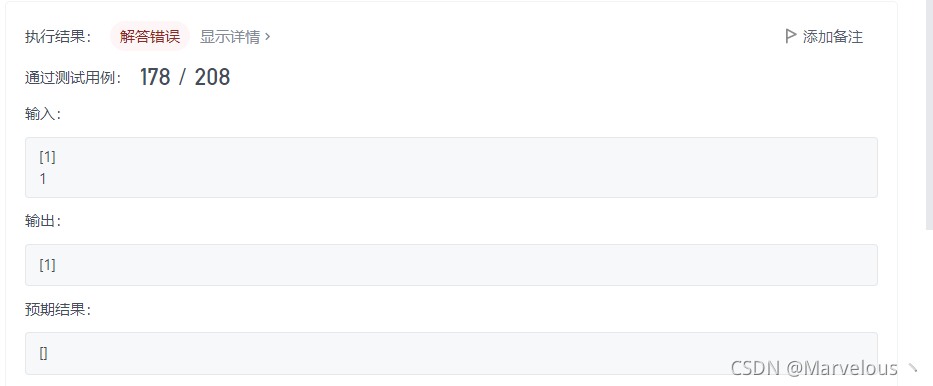Tips:There is something noteworthy in C++ code,function getlen(LinkList * head),this formal parameter?is fake,if we call this?funtion,our?actual parameter head will not change。That is different from array,for instance int fun(int a[]),it will change our actual parameter。?
Another one,if I write LinkList* head2 = head;If I change head2,it will not effect??head,or if I change head,it will not change head2 either.?
Solution 1:

? My First answer was?wrong? , I didn't??take this case into consideration.But the idea of?predecessor and?successor is not bad ,awesome,almost right.
?So I save the dommy node,do not operate the predecessor,that made a change.For this [1] case,we can not use head anymore,if head was moved,then we return head,there is no use,even we write cur -> next = null , it will not affect "head". That's the point.
Consider deletion of linklist。 We can imagin one roads,if we delete node "a","a" change the way。
class Solution {
public:
int getlen(ListNode *head){
int len = 0;
while(head){
len++;
head = head->next;
}
return len;
}
ListNode* removeNthFromEnd(ListNode* head, int n) {
ListNode *head2 = head;
int len = getlen(head);
len = len - n + 1;
ListNode *pre =new ListNode(0,head);
ListNode *dommy = pre;
ListNode *cur = head;
for(int i = 1; i < len ;++i){
pre = pre->next;
cur = cur->next;
}
pre -> next = cur -> next;
cur -> next = nullptr;
return dommy->next;
}
};# Definition for singly-linked list.
# class ListNode(object):
# def __init__(self, val=0, next=None):
# self.val = val
# self.next = next
class Solution(object):
def removeNthFromEnd(self, head, n):
def getlen(head):
length = 0;
while head:
length+=1
head = head.next
return length
length = getlen(head)
length = length - n + 1
dummy = ListNode(0,head)
cur = dummy
for i in range(1,length):
cur = cur.next
cur.next = cur.next.next
return dummy.next?Solution 2
?We can use??two-pointer technique,when ed reach the end the position of st is the position to delete.?
class Solution {
public:
ListNode* removeNthFromEnd(ListNode* head, int n) {
ListNode *st = new ListNode(0,head);
ListNode *ed = head;
ListNode *dummy = st;
for(int i=0;i<n;++i)
ed = ed->next;
while(ed){
st = st->next;
ed = ed->next;
}
st->next = st->next->next;
return dummy->next;
}
};class Solution:
def removeNthFromEnd(self, head: ListNode, n: int) -> ListNode:
dummy = ListNode(0, head)
stack = list()
cur = dummy
while cur:
stack.append(cur)
cur = cur.next
for i in range(n):
stack.pop()
prev = stack[-1]
prev.next = prev.next.next
return dummy.next
作者:LeetCode-Solution
链接:https://leetcode-cn.com/problems/remove-nth-node-from-end-of-list/solution/shan-chu-lian-biao-de-dao-shu-di-nge-jie-dian-b-61/
来源:力扣(LeetCode)
著作权归作者所有。商业转载请联系作者获得授权,非商业转载请注明出处。?Solution 3
Stack , my favorite solution。Pay attention to python version , prev = stack[-1] means,the last element,list is circular?
class Solution:
def removeNthFromEnd(self, head: ListNode, n: int) -> ListNode:
dummy = ListNode(0, head)
first = head
second = dummy
for i in range(n):
first = first.next
while first:
first = first.next
second = second.next
second.next = second.next.next
return dummy.next
作者:LeetCode-Solution
链接:https://leetcode-cn.com/problems/remove-nth-node-from-end-of-list/solution/shan-chu-lian-biao-de-dao-shu-di-nge-jie-dian-b-61/
来源:力扣(LeetCode)
著作权归作者所有。商业转载请联系作者获得授权,非商业转载请注明出处。class Solution {
public:
ListNode* removeNthFromEnd(ListNode* head, int n) {
ListNode* dummy = new ListNode(0, head);
stack<ListNode*> stk;
ListNode* cur = dummy;
while (cur) {
stk.push(cur);
cur = cur->next;
}
for (int i = 0; i < n; ++i) {
stk.pop();
}
ListNode* prev = stk.top();
prev->next = prev->next->next;
ListNode* ans = dummy->next;
delete dummy;
return ans;
}
};
作者:LeetCode-Solution
链接:https://leetcode-cn.com/problems/remove-nth-node-from-end-of-list/solution/shan-chu-lian-biao-de-dao-shu-di-nge-jie-dian-b-61/
来源:力扣(LeetCode)
著作权归作者所有。商业转载请联系作者获得授权,非商业转载请注明出处。